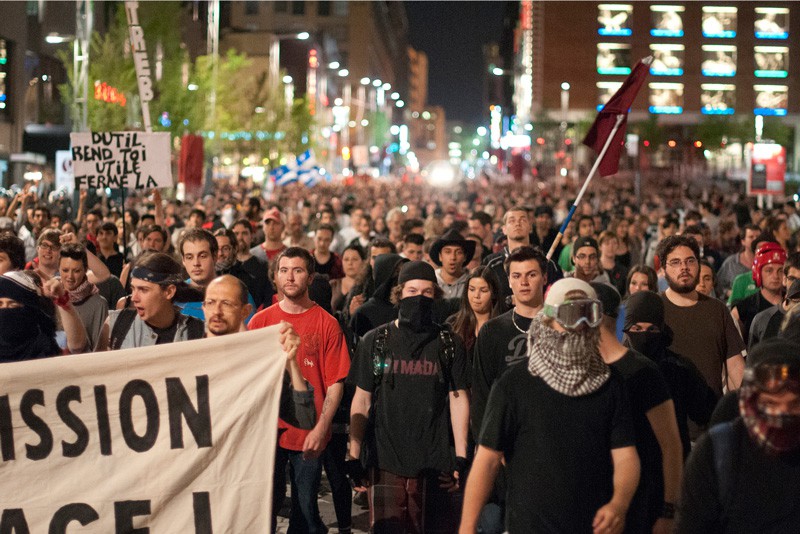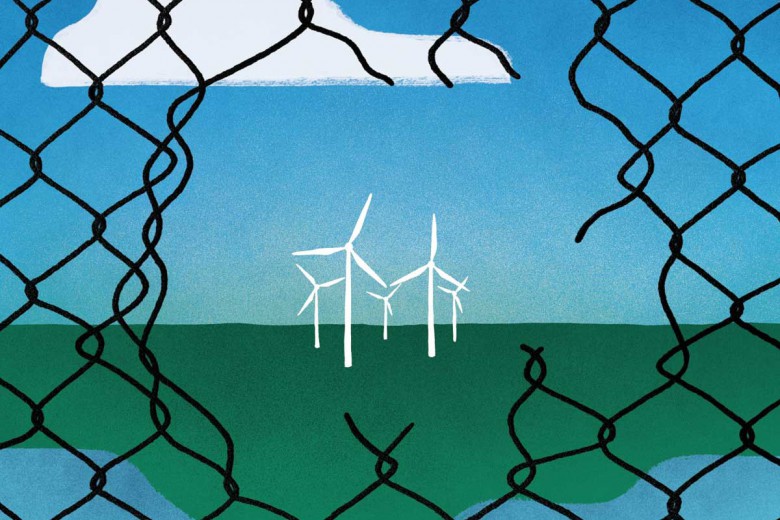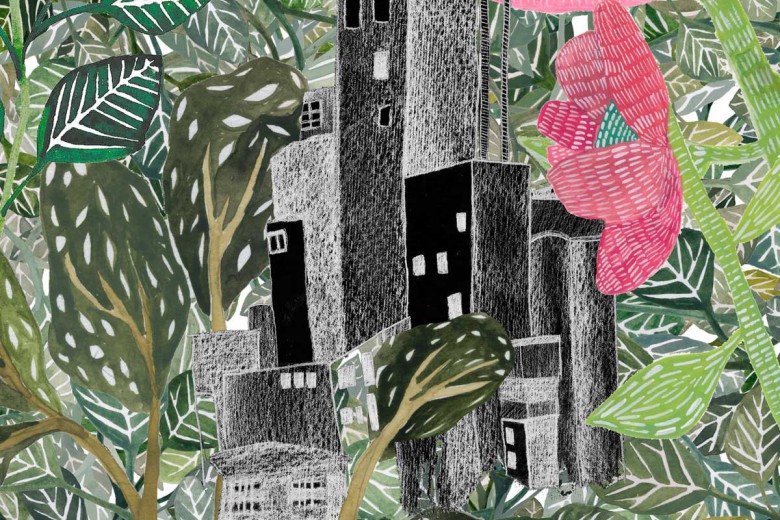
Over the course of several months, a wave of media coverage in anglophone Canada and internationally has made the social movement emerging out of Quebec nearly synonymous with the casseroles, the festive nightly marches that filled Montreal streets with the clamour of pots and pans. Corresponding with its heavy presence in global news coverage, the casserole has been the unit of the Quebec protests most frequently and widely reproduced in international expressions of solidarity, with casseroles appearing at rallies and marches in dozens of North American cities and as far away as Paris and Rio de Janeiro.
A creative intervention in a movement already noted for the artistry and performance marking its protests, the casseroles brought new energy to the struggle and set the tone for massive, open defiance of the Special Law (Bill 78), the Charest administration’s anti-protest edict. Casseroles were also a counterpoint to the riots that had shaken Montreal streets and a more accessible space for broad-based dissent. While diverse views on the casserole protests circulate within Quebec, the extent to which they have become the centre of outside narratives of the strike is certainly unexpected to most of us who, since mid-February or earlier, have taken to the streets of Quebec.
In March, a month after the strike was launched and before the student protests generated widespread coverage outside of Quebec, headlines and Twitter feeds here looked very different. No #casserolesencours. Instead, it was early morning port blockades and students massed in front of banks or on bridges, pushing back against the riot squad of the Service de Police de la Ville de Montréal (SPVM), that were the subject of discussions. The strategy was economic disruption, and the tactic was the manif-action (demo-action).
On March 10, by a vote of 64-0, the congress of CLASSE approved a motion calling for a week of actions disrupting the economy and the state beginning March 26, following the 200,000-person demonstration of March 22. While this call was made by CLASSE, the manif-actions were organized autonomously by affinity groups working outside of the formal structures of CLASSE and local student associations.
This campaign was not without precedent. As a form of action and means of escalating pressure, the manif-action was used during the 2005 student strike in Quebec and, more recently, in two blockades in early 2012: the stock exchange tower on February 16 (also the day of the occupation of the CÉGEP du Vieux-Montréal) and then the offices of Loto-Québec and the CREPUQ (a Quebec-wide university governing body) on March 7. The stock exchange tower blockade was organized by the Coalition Against User Fees and the Privatization of Public Services, which brings together over 100 community groups, student associations, and labour unions. Hundreds of students participated. Pushing to the foreground an agenda much broader than the university tuition hike, the Coalition action prefigured a theme that has marked the longest student strike in Quebec history – the insistence that the tuition hike cannot be isolated from other struggles or from the political and economic structures that collectively underlie them.
Fields of contestation
The manif-actions were a logical extension of the strike. Students were on strike, in part, to put pressure on the government. The act of striking in itself accomplishes this by disrupting the routine of academic institutions, with classes empty, picketed, and suspended indefinitely. Yet the strike also frees up time and resources to organize and participate in actions outside of the campuses. We can distinguish here between isolated days of action, which can be planned by student unions and attended by students as they continue to go to class, and sustained campaigns of disruptive activities, which necessitate a larger, more diverse organizing base. Central to the success of the strike is building capacities for the latter.
On another level, the classroom pickets by which students implemented the strike mandates of their local student unions’ general assemblies allowed many to envisage the possibility of blocking access to other spaces. That the blockade model spread to targets implicated in neoliberal capitalism, wherein profit matters above all else and education is a commodity available to those who can afford to pay, came as no surprise. Blockading economic centres that play a vital role in devising and implementing neoliberal policies was a logical progression from the disruption of the education system, one of the many sites of neoliberal transformation.
The neoliberalization of higher education – the extension of the logic of capital into the university where students become clients bound to pay a “fair share” of the market value of their degree – arises from a crisis of capitalism, which produces an ever-intensifying search for new markets, new kinds of commodities, new kinds of production and consumption. The tuition fee hike is a direct manifestation of neoliberalism and demands a form of resistance that recognizes these links and acknowledges that the classroom and the boardroom are not separate spaces. That the principal of an elite Montreal university sits on the board of directors of the Royal Bank of Canada is only one example among many of the merger between the management of capitalist production and control of the production and circulation of knowledge, otherwise known as education. A leaflet distributed to participants in a bank blockade read, in part: “Our presence here rests on much more than the struggle for accessible education. The objective? To disrupt the flows of capital that govern too much of our society while constantly impeding equity and social justice. On one hand, the general decline in the accessibility of education as well as cuts to government loans entail an ever-greater dependence on bank loans, and banks profit massively from student debt. On the other, these institutions and their agents finance the oppression of peoples and the theft of natural resources, here and elsewhere.”
The discursive space of the manif-action in this way drew connections between its economic target and the student strike, and between the generally narrow scope of student demands and wider fields of contestation. The progression from blocking classrooms to blocking banks was not only logical but necessary to broaden the struggle and escalate the offensive against capital, its managers, and its defenders.
The manif-actions fit into a long-term strategy of escalation at the grassroots level of the Quebec student movement and reflected at CLASSE. The strike did not begin spontaneously but was the result of gradual mobilization over almost two years against an impending tuition hike, announced in March 2010 but anticipated several months earlier. Before the unlimited general strike, there were information campaigns (posters, leaflets, websites, stickers, graffiti) addressing the hike and what it would mean for students, conferences, workshops, training camps, petitions, rallies, marches, and symbolic actions.
Red squares multiplied, and one-day strikes culminated in the national day of action on November 10, 2011. This progressive escalation, which depended at every step on mass support within local student associations and beyond, was essential to building the mobilizing capacity that is today unparalleled on the Left in North America.
At the same time, it would be wrong to portray Quebec students as a homogeneous movement, advancing from stage to stage of mobilization as a unified force. While there has been a general progression from an information-based campaign to one focused on direct action, a diversity of tactics has been deployed from the beginning. As early as April 1, 2010, 40,000 students participated in a one-day strike, and less than five months later, 50 students occupied the office of Education Minister Line Beauchamp (who resigned in May 2012). This diversity of tactics, a natural correlate of Quebec students’ decentralized, autonomous organizing structures, played an important role in warning the state about how far students were prepared to go and opening up possibilities for students who may have been unaccustomed to more direct forms of protest.
Underlying the escalation of the manif-action were two distinct projects. First, many in the combative wing of the student movement wanted to strengthen their position in relation to state power to force Premier Charest and Education Minister Beauchamp to grant concessions on CLASSE’s demands. Organizers knew that the polls commissioned by corporate media following disruptive actions, claiming to show declining support for the students, were techniques of pacification. In addition to extracting concessions, economic disruption was a means of actively opposing the violence of capitalism.
Occupy, block, disrupt
In specific terms, what does a manif-action look like? A small group of organizers plan an action, selecting a target, scouting it, and deciding how a few hundred people could best block, occupy, or otherwise disrupt it. With the target known only to the organizers, who remain anonymous, a meeting point and time are publicized via leaflets, general assemblies, and social media a few days or a week in advance. Sometimes the call-out includes a colour-coded risk level. People gather at a park or outside a metro station and move to the target. If there are multiple entrances to block, the crowd may split up before arriving at the target, where they usually remain until police force them out or they make a collective decision to leave.
In late March and April, manif-actions blockaded the Port of Montreal, the headquarters of National Bank, the distribution centre and main office of the state-owned liquor board, several bridges, and the Ministry of Education. They occupied city halls, courthouses, and government buildings across the province and disrupted events, including a National Bank shareholders’ meeting in a Montreal hotel. Manif-actions were accompanied by a number of high-impact actions carried out by individuals and smaller groups, most notably a series of metro smoke bombings that culminated in the total shutdown of the Montreal metro system during the morning rush hour of May 10.
Some blockades targeted bridges that connect the island of Montreal to the suburbs on the south shore of the St-Lawrence River. Accomplished sometimes simply by a mass of people approaching a bridge entry point, provoking lines of provincial police to block the bridge themselves, these blockades were also a nod to other struggles that had blocked access to the city with similar actions, such as during the Oka Crisis in 1990 when the Mercier bridge was blocked by the Mohawks of Kahnawake.
The bridge blockades took the manif-action a step further. On one hand, they were another form of blocked access staged to parallel the effects of the tuition hike on accessibility to post-secondary education. On the other, as a way of disrupting the economic center of Quebec, they responded to a situation in which everyone is implicated in the continued functioning of a capitalist economy, and in which neoliberal policies affect broad sections of the population – not just students – with a health tax and hydroelectricity rate hike on the table in Quebec alongside the tuition hike. The blockades were an escalation asserting that no one is outside the rule of the “free market” or the imperatives of its survival.
The economic disruption of the manif-actions elicited the most consistently violent police reaction seen during the student strike. The SPVM, known to be one of the most brutal police forces in North America, systematically deployed its riot squad to break blockades by force. Those standing in the way of employees entering a workplace, or of goods reaching a seller, routinely faced pepper spray, tear gas, the blows of batons, and arrest. Ski goggles and masks became common defenses against chemical weapons, and protesters learned to shield their faces from the shrapnel of exploding rubber ball grenades, which the SPVM continued to use despite a study concluding they are highly dangerous and after they had permanently damaged one student’s vision.
Balance of power
Repeated confrontations with police had the effect of demarcating a newly widened struggle and of bringing to light lines between protesters and those authorized to intimidate, repress, and incapacitate us. Arguably, they prepared the stage for the climactic hours of April 20, when a manif-action intended to cancel a job fair for Plan Nord – an $80 million development project intended to open the unceded Indigenous territories of northern Quebec to large-scale mining projects – resulted in sustained street battles between protesters and police. After protesters smashed the windows of and briefly penetrated a downtown convention centre where Premier Jean Charest was preparing to speak, multiple groups swarmed the area, lighting fires, building barricades in the street, and launching rocks and other projectiles at lines of police. The SPVM was unable to control the rioting, and with injuries on both sides mounting, the Sûreté du Québec (Quebec provincial police) riot squad entered the city of Montreal for the first time in the conflict.
April 20 represented a breakthrough in that, for the first time, protesters fought back in a concerted way against the police, not only reacting to specific instances of violence but attacking lines of cops readying for their next charge. To those struggling for meaningful social change, the day’s events clearly identified the police as an institution that protects the ruling elite. Confusion on this point has only weakened the movement. Discourses based on good and bad cops or proper and improper police action – for example, when commentators congratulate police for making targeted arrests rather than kettling dozens of protesters – ultimately result in easier arrests, more criminal charges and stricter release conditions, divisions between “good” and “bad” protesters, and reduced capacities for resistance and solidarity.
The manif-actions generated a surge of disruption that the forces of order could not control, shifting the balance of power between students and the government to the point where Charest granted small concessions, expanding the student financial aid program and, later, stretching the tuition hike to $254 per year over seven years rather than $325 per year over five.
A social war had spilled from the campuses into the streets, and in the political battle over education policy, students appeared to have the upper hand. Then, slowly, the manif-actions faded from view. Fewer were organized, and the ones that were often attracted too few people for the action to be conducted. How do we account for this decline? In part, with nightly protests in response to failed negotiations frequently lasting past 1 a.m., ending in narrow escapes from police if not hours in detention, students gradually became less able to attend 7 a.m. and 8 a.m. actions where further confrontation with police was assured. Few people anticipated that the strike would extend beyond April, and physical and mental exhaustion took a toll. The manif-actions were believed to be the final escalation needed to block the hike. Faced with the intransigence of the Liberal government, the decentralized organizing structures that gave rise to the manif-actions also allowed new forms of action to sustain the movement in creative, novel ways.
At the same time, courts issued injunctions that required CÉGEPs and universities to resume teaching activities. The injunctions made it illegal for schools to respect student strike votes, forcing students to return to active strike enforcement. Those able to face off with police early each morning were now blocking CÉGEPs and university entrances, not banks. As an effort to break the strike, the injunctions failed. Campus blockades generally held until administrations were compelled to cancel classes as scenes of riot police bloodying students on their own campuses and forcefully expelling red-square-wearing teachers from school buildings unfolded throughout Quebec. With the injunctions, however, the state had activated its judicial apparatus in a provisional move that effectively forced students out of the business district and back onto their campuses, reversing the spread of social war. As a technique of containment, the injunctions put the militant wing of the movement on the defensive and restored a measure of peace for the capitalist class.
In an age where the dictums of fund managers and state economists echo through lecture halls and research labs, the student strike was always a form of economic disruption in itself. The strike as withdrawal from academic activity delays the entry of graduates into the taxpaying workforce, entails millions of dollars in government losses to teacher and staff salaries, and, most importantly, threatens to force the cancellation of the semester – a financial and logistical catastrophe for the state. After the injunctions failed to break the strike and alleviate this threat, the Liberal government passed the Special Law, which suspended the winter semester at CÉGEPs and university departments affected by the strike, mandated a return to class in mid-August for a condensed session, instituted steep fines for anyone who impedes access to classes, and restricted freedom of assembly.
For the state, the Special Law’s suppression of the strike came at a price: a broadened social movement. From windows and balconies, and later the streets, casseroles began as a stirring form of protest against the Special Law by a broad segment of the population in which students were a minority. Unlike the tuition hike, which could easily be compartmentalized as a “student issue,” the Special Law affected everyone. The casseroles presented a prime example of a movement effectively triggering a level of state repression that, instead of crushing it, helps it to grow by eliciting the active defiance of people previously hesitant to take a stand.
In what ways did the manif-actions lead to the Special Law and the broadened social movement to which it gave rise? First, they generated enough pressure for the government to finally open negotiations with students and were a means of leverage that enabled us to stand firm on our demands. We were able to allow dialogue to fail. Second, they contributed to a rising capacity to defend ourselves and to fight back, whether at Plan Nord on April 20 or at the more intense night protests in the days thereafter. Finally, the manif-actions attracted the participation of non-students, which posed the threat of a broader social movement emerging. In these ways, the manif-actions played a central role in provoking the social crisis – that is, the unearthing of preexisting antagonisms and contradictions – to which the Liberal government responded with the Special Law.
With constitutional challenges to the Special Law pending in Quebec courts, the fate of the student movement very much depends on whether the law will be massively defied beginning August 13, when three of 14 CÉGEPs are scheduled to reopen for the completion of the suspended winter semester. Student strikes in Quebec never sought legitimacy in the codifications of law, but never before has upholding student democracy so directly required massive civil disobedience. May 22 saw the largest act of civil disobedience in the history of North America as 300,000 people answered the call of CLASSE to defy the Special Law restricting freedom of assembly and take to the streets of Montreal. Going forward, the challenge lies in continuing to defy the law and block classes and campuses. In order to give a further push to Quebec’s historically powerful student movement, a call has been made for an international convergence in Montreal from August 13 to 17 to block the return to class across Quebec.
While sustaining the economic disruption of the strike will allow the movement to survive, organizing must also aim at renewing a struggle that goes beyond the campuses, that extends spaces of contention into the infrastructures of capital. Toward such an end, the manif-action may or may not re-emerge as a favoured tactic, but escalation in some form is essential. The machinations of police and legal repression have not made direct action impossible; rather, they present challenges that must be overcome.






